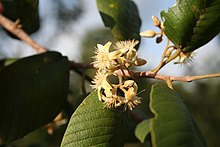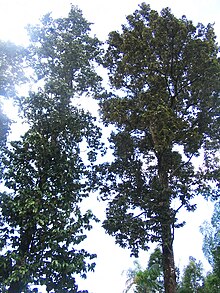Wing fruit plants
| Wing fruit plants | ||||||||||||
|---|---|---|---|---|---|---|---|---|---|---|---|---|

Dipterocarpus retusus , illustration |
||||||||||||
| Systematics | ||||||||||||
|
||||||||||||
| Scientific name | ||||||||||||
| Dipterocarpaceae | ||||||||||||
| flower |
The wing fruit plants (Dipterocarpaceae) are a family in the order of the Mallow-like (Malvales). Fossil finds have existed at least since the Tertiary : For example Anisopteroxylon and Dryobalanoxylon from sites in the central plains of Myanmar in Burma (Middle Miocene ). After amber, which is around 50 million years old and is attributed to resin from wing fruit plants, was found in northern India ( Gujarat province ), it must be assumed that at least in northern India extensive areas were covered with trees from this family as early as the Eocene .
description
They are mostly evergreen trees , some species shed some of their leaves during the dry season. Some species are very resinous. There are small trees, but some species are the largest trees (known in Asian lowland rain forests over container ). Typical for most species is their tall, straight trunk (at least up to 10 meters high), unbranched. The bark is often cracked. Stipules are present (in some species they fall off quickly). The alternate, stalked leaves are simple, entire and leathery.
The hermaphrodite, radially symmetrical flowers are five-fold; they are mostly big. There are five sepals and five petals per flower , usually 15 (5 to 110) stamens and two to three fused (syncarpic) carpels . The ovary is upper constant, each ovary cell contains two to four ovules . Solitary closing fruits with woody pericarp (nuts, capsule fruits ) are formed. The sepals remain until the fruit ripens, often two to every five enlarges during ripening. They usually form the typical long wings (names of the whole family!). The fruits are mostly wing fruits (pseudosamaras) → wing nuts .
The trees often form the typical buttress roots , as can be found in many tropical trees. Some species form the top tier of the rainforests, the lower part of the trunks rarely have branches, at the top they usually only form a sparse crown. The pollination is usually by insects.
use
Species from this family dominate the native Asian rainforests. They make up hardwood (also known as keruing ). These species are the main reason for the overexploitation in the Indo-Malay rainforests. For example, their wood accounts for 85% of Indonesia's wood exports. Efforts are being made to reforest with these species.
The resin, which is often abundantly produced, is used (in Borneo it is called "damar"). For example, it is used for dyeing batik and as a binder for water-soluble colors. Damma resin from the South Asian variety Vateria indica provides the raw material for binding agents in paints and varnishes , embedding agents for microscopic specimens and for plasters.
Gurjun balm and Gurjun balm oil are obtained from wing fruit tree species ( Dipterocarpus ). You create a cavity in the trunk of the tree and light a fire in it, which stimulates the outflow of the Gurjun balm.
ecology

Fattening years are a phenomenon that occurs in species of this family, but also in other tree families. Trees of one kind bloom at the same time and produce fruit for a few months. This has far-reaching consequences for the ecosystem, because at this time the pollinating insects multiply rapidly, which in turn form the food source for other animals. The fruit-eaters also multiply. In the following years no or only very few fruits are formed. The advantage for the plants is that although the fruit-eaters are satisfied, the high number of seeds and seedlings leaves enough to ensure the survival of the species. It is known that this phenomenon is triggered by the ENSO events ( E l N iño / S outhern O scillation ). By cutting down the old fruiting trees, this part of the ecosystem is no longer intact.
For example, at altitudes from 0 to around 750 meters, the lowland mixed dipterocarp forests are the most species-rich and ecologically complex forests in Brunei , 13 to 24% of the trees in them are Dipterocarpean species.
distribution
They have a predominantly palaeotropic distribution, they are less common in the Neotropic . They have a focus of biodiversity in the Indo-Malaysian region.
Systematics
The Dipterocarpaceae family was established in 1825 by Carl Ludwig Blume in Bijdragen tot de flora van Nederlandsch Indië , p. 222. A synonym for Dipterocarpaceae flower is Monotaceae Kosterm.
The wing fruit family (Dipterocarpaceae) is divided into three subfamilies and 17 genera with 680 species:
- Subfamily Dipterocarpoideae Burnett : With 13 genera and about 650 species in the Indo-Malaysian area:
- Anisoptera Korth. : With about ten species that occur between Bangladesh and New Guinea. The wood is used by some species under the trade name Krabak .
- Cotylelobium Pierre : With six species that occur in Sri Lanka and western Malesia.
- Two-winged fruit trees , winged fruit trees ( Dipterocarpus C.F.Gaertn. ): With about 70 species in Southeast Asia.
- Dryobalanops C.F.Gaertn. : With seven kinds; they occur in Malesia.
- Hopea Roxb. : With about 105 species that occur in Indomalesia.
-
Neobalanocarpus P.S. Ashton : Is a monotypic genus on the Malay Peninsula:
- Neobalanocarpus heimii (King) PSAshton
- Parashorea in short : With around 15 species that occur in southern China, Southeast Asia and Malesia.
- Shorea Roxb. ex CFGaertn. : With around 200 to 360 species that occur from Sri Lanka to China and Indonesia.
- Stemonoporus Thwaites : With about 20 species that occur in Sri Lanka.
-
Upuna Symington : Is a monotypical genus in Borneo :
- Upuna borneensis Sym.
- Vateria L .: With only two species, one of which occurs in India and the other in Sri Lanka.
-
Father Iopsis F. Heim : With only one species:
- Father Iopsis seychellarum (Dyer) F.Heim ; it occurs in the Seychelles .
- Vatica L .: With about 60 species; they occur in Indomalesia.

- Subfamily Monotoideae Gilg : With three genera and about 30 species, in Africa , Madagascar and South America:
- Monote A.DC. : With about 26 species that occur in tropical Africa and Madagascar.
- Marquesia Gilg : With four Artem that occur in tropical Africa.
-
Pseudomonotes A.C. Londoño, E. Alvarez & Forero : Is a monotypic genus in the Colombian Amazon lowlands :
- Pseudomonotes tropenbosii A.C. Londoño, E. Alvarez & Forero .
- Subfamily Pakaraimoideae Maguire, PSAshton & C.de Zeeuw : It is a monotypical taxon with only one genus and one species:
-
Pakaraimaea Maguire & PSAshton :
- Pakaraimaea dipterocarpacea Maguire & PSAshton : Home is the Guyana highlands in South America .
-
Pakaraimaea Maguire & PSAshton :
swell
- Description of the Dipterocarpaceae family on the AP website. (Section description, systematics and use).
- Description of the Dipterocarpaceae family at DELTA by L. Watson & MJ Dallwitz. (Section description)
- Xi-wen Li, Jie Li & Peter S. Ashton: Dipterocarpaceae in der Flora of China , Volume 13, 2007, p. 48: online (section description).
- David John Mabberley: Mabberley's Plant-Book. A portable dictionary of plants, their classification and uses . 3rd ed. Cambridge University Press 2008, ISBN 978-0-521-82071-4 .
Individual evidence
- ↑ Post in scinexx about amber from Gujarat
- ↑ Ludwig Kammesheidt: The Dipterocarp forests of Southeast Asia. Ecology, use and future of a unique natural heritage. In: Naturwissenschaftliche Rundschau. 60 (6), 2007, pp. 285-292, ISSN 0028-1050 .
- ↑ Dipterocarpaceae in the Germplasm Resources Information Network (GRIN), USDA , ARS , National Genetic Resources Program. National Germplasm Resources Laboratory, Beltsville, Maryland.
- ↑ Dipterocarpaceae in the Germplasm Resources Information Network (GRIN), USDA , ARS , National Genetic Resources Program. National Germplasm Resources Laboratory, Beltsville, Maryland.
- ↑ a b c d e f g h i j David John Mabberley: Mabberley's Plant-Book. A portable dictionary of plants, their classification and uses. 3rd Ed., Cambridge University Press, 2008, ISBN 978-0-521-82071-4 .


